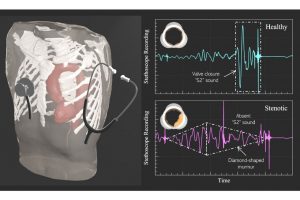
Cardiac auscultation, or listening to heart sounds with a stethoscope, is a fast and inexpensive way to screen for cardiac defects or conditions, and one that has been used for centuries. Despite its advantages, auscultation is a specialized skill that can be tough to master without extensive clinical experience -– meaning a valuable diagnostic tool is falling into disuse.
Johns Hopkins University researchers are hoping to revive cardiac auscultation by coupling it with computational modeling and machine learning. Rajat Mittal runs the Flow Physics and Computation Lab, where he and fourth-year doctoral student Shantanu Bailoor developed an algorithm that “listens” to heart sound recordings and detects heart disease with an accuracy that is similar to that of expert cardiologists.
“Our computer-assisted auscultation was able to accurately detect heart valve failure up to 90% of the time,” said Mittal, a professor in the Department of Mechanical Engineering at Johns Hopkins Whiting School of Engineering.
The initial findings of the research will be presented at the American Physical Society’s 74th Annual Meeting of the APS Division of Fluid Dynamics, held November 21-23, 2021.
Heart sounds are produced by turbulent flow of blood, and contain vast amounts of disease-related information. In their study, the researchers set out to investigate the generation of murmurs, or abnormal heart sounds related to defective heart valves.
Using computational modeling, the scientists created simulations of cardiac blood flow as well as the associated heart sounds of both healthy and defective heart valves. Using insights from their simulations, they designed a machine learning algorithm which listens to heart sound recordings and identifies murmurs that should be examined further.
Bailoor said their results have exciting implications for smart stethoscopes powered by machine learning, which could help repopularize the centuries-old technique of cardiac auscultation.
“Automated cardiac auscultation alleviates some of the subjectivity in auscultation-based diagnosis. We think this technology can be very useful for the early detection and monitoring of heart valve failure and other cardiac conditions,” said Bailoor.
The software has potential to not only assist cardiologists during patient exams, but also to advance home-based and more affordable cardiac screening and monitoring, he adds.
“Our technology can be used to design accurate digital stethoscope platforms, which can facilitate at-home preliminary screening of heart diseases without a trained physician, and empower patients to take greater responsibility for their own health,” said Bailoor.
Other scientists who conducted the research are Jung Hee Seo, associate research professor of mechanical engineering, and Stefano Schena, assistant professor in the Johns Hopkins Division of Cardiac Surgery. The work was supported by the 2020 Mirowski Discovery Award, presented by the Johns Hopkins University Division of Cardiology.